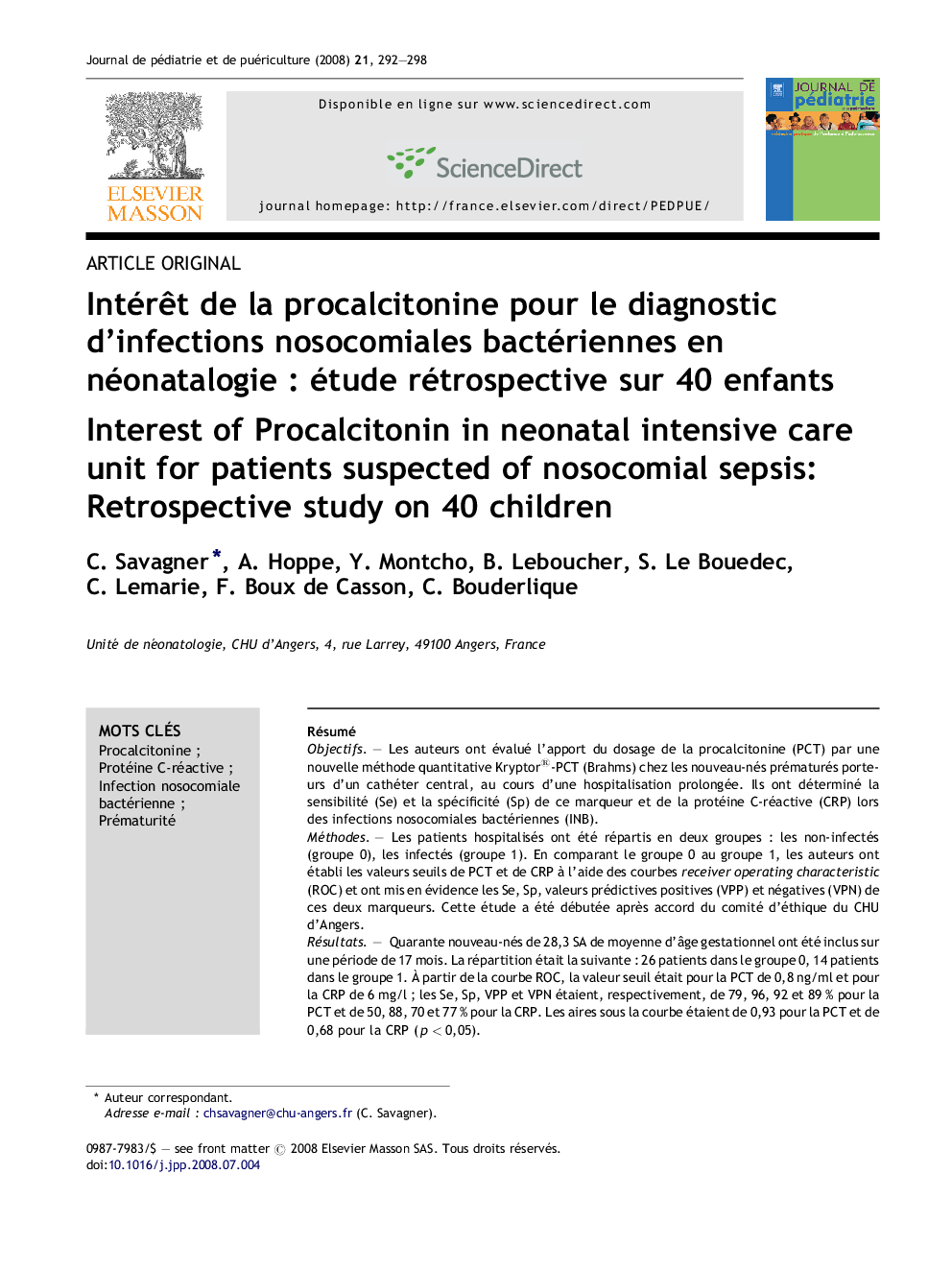| Article ID | Journal | Published Year | Pages | File Type |
|---|---|---|---|---|
| 4170546 | Journal de Pédiatrie et de Puériculture | 2008 | 7 Pages |
RésuméObjectifsLes auteurs ont évalué l’apport du dosage de la procalcitonine (PCT) par une nouvelle méthode quantitative Kryptor®-PCT (Brahms) chez les nouveau-nés prématurés porteurs d’un cathéter central, au cours d’une hospitalisation prolongée. Ils ont déterminé la sensibilité (Se) et la spécificité (Sp) de ce marqueur et de la protéine C-réactive (CRP) lors des infections nosocomiales bactériennes (INB).MéthodesLes patients hospitalisés ont été répartis en deux groupes : les non-infectés (groupe 0), les infectés (groupe 1). En comparant le groupe 0 au groupe 1, les auteurs ont établi les valeurs seuils de PCT et de CRP à l’aide des courbes receiver operating characteristic (ROC) et ont mis en évidence les Se, Sp, valeurs prédictives positives (VPP) et négatives (VPN) de ces deux marqueurs. Cette étude a été débutée après accord du comité d’éthique du CHU d’Angers.RésultatsQuarante nouveau-nés de 28,3 SA de moyenne d’âge gestationnel ont été inclus sur une période de 17 mois. La répartition était la suivante : 26 patients dans le groupe 0, 14 patients dans le groupe 1. À partir de la courbe ROC, la valeur seuil était pour la PCT de 0,8 ng/ml et pour la CRP de 6 mg/l ; les Se, Sp, VPP et VPN étaient, respectivement, de 79, 96, 92 et 89 % pour la PCT et de 50, 88, 70 et 77 % pour la CRP. Les aires sous la courbe étaient de 0,93 pour la PCT et de 0,68 pour la CRP (p < 0,05).ConclusionCette étude confirme l’intérêt du dosage de la PCT dans le diagnostic des INB en néonatalogie. La PCT est un marqueur de l’infection bactérienne ayant une cinétique précoce.
SummaryObjectiveThe authors have evaluated the contribution of procalcitonin (PCT) assay to monitor bacterial nosocomial infection (BNI) of premature newborns carrying a venous central catheter during a prolonged hospitalization. Using the quantitative KRYPTOR®-PCT method, they determined the sensitivity (Se) and the specificity (Sp) for PCT and C-reactive protein (CRP).Materials and methodsNewborns with a suspicion of BNI were included. They were divided into two groups: not infected (group 0), infected (group 1). Comparing the two groups, the authors established a threshold value for PCT and CRP using the ROC curves. We also highlighted Se, Sp, positive (VPP) and negative predictive values (VPN) for PCT and CRP.ResultsForty premature newborns of 28.3 weeks gestational age average were included during a 17 months period. The distribution was as follows: 26 patients in group 0 and 14 patients in the group 1. The threshold value was 0.8 ng/ml for PCT, 6 mg/l for CRP. The Se, Sp, VPP and VPN values were 79, 96, 92 and 89% for PCT, 50, 88, 70 and 77% for CRP. From the ROC curves, the surface under curve was 0.94 for PCT, 0.68 for CRP (p < 0.05).ConclusionThis study confirms the interest of PCT assay in the diagnosis of BNI in premature newborns. The PCT is an early marker of bacterial infection in Neonatal Intensive Care Unit.
